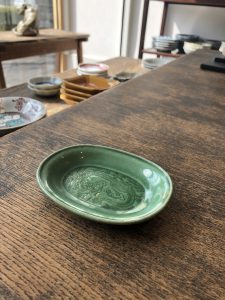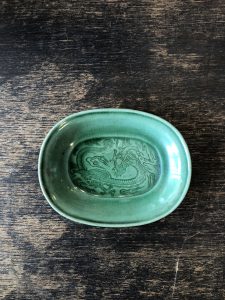今日は、「緑」ではなく「萌黄色」と言ってみようかと。(愛知県名古屋市千種区姫池通 骨董買取いたします 古美術風光舎名古屋店)
2022.04.13
みなさま、こんにちは。スタッフYでごさいます。

今朝仕事にて外をまわっていますと、ここ一日二日で新緑が待っていましたとばかりの勢いに芽吹いていますね。
そんな美しい新緑を眺めておりますと、新緑の「緑」が様々であり、その様々な様子がなんともいえぬ絵画のように見えてまいり、絵が上手に描けたらどんなにかよかったのになと、思った次第でごさいます。
そんな「緑」、新緑の緑をみていましても一派一絡げとはいかず、少し黄色味を帯びていたり、青みを帯びていたり、薄かったり濃かったり様々。
こんなに様々であるにもかかわらず、古代では寒色系統を総括的にアオと呼び、草木の緑系統の色もアオであったようですから、当時はそもそも色を区別する概念がそんなになかったか。こんなに違っているのに。
そういっても、後の平安時代以降は 木の芽や若葉の色を「萌黄」と用いることが多かったようであります。「緑」は存在していたようですが、『万葉集』や『延喜式』の中にもみられますように、あまり用いられることは少なかったようですね。
そんな万葉集に、現代人の私たちの感覚でも美しいなと思える「緑」の登場する歌がありましてご紹介いたします。
作者不明はでございます。
「浅緑染め懸けたりと見るまでに春の柳は萌えにけるか」」
~まるで浅緑に染めた糸を掛けたように、春の柳がが芽吹いています。
と、ここでは「緑」が詠われております。ですが、普段「緑」として使われていたのは「萌黄」が主流だたのでようですから、当時の人にとっては馴染みのない文学的な言葉にすぎなかったのでしょうか。
ですが、芽吹き始めた柳の新緑を繊細な緑の糸に例え、そんな柳が風に揺れるほんのり軽やかな春の情景を当時の人も美しいと思い表現したかったのでしょうか、素敵な歌ですね。
そんな「萌黄」をはじめ伝統色ですが、緑にちなんだ色だけでも現在は82色もあるようです。
お分かりのように、宝石・動物・鳥に由来する色名が少なく、植物的な発想に基づいているものが 多く、固有色名というより漠然とした萌黄や若草色などの色名が多く使われております。緑に関しては、植物に由来することは大いに理解できますし、植物からの由来の名前のほうが逆に私たちにはイメージができやすいようにも思えますね。
とまあそのネーミングでの植物のイメージの紐づけは大いに理解できますが、昔はさらに一歩先のその色の持つ意味のイメージが存在しましたよね。たとえば、有名な冠位十二階。これは、色によって位をつけていたり、「紫」が高貴な位だったことはみなさん、かつての歴史の教科書で学びましたよね。
そんな色の持つイメージが「萌黄色」にも存在しているようですね。それが鎧の縅(おどし)や太刀などの配色に組み込まれているようで、その人物の地位や立場などを語る道具だてにもなりました。
縅には緋色や黒、紫などが好まれたようですが、苅安(カリヤス)で黄色に染めた布を藍(アイ)でさらに染めた萌黄色もございました。
そんな萌黄色の縅にちなんだ話が「平家物語」に登場致します。
萌黄色の意味は若く血気盛んな意味であったのでしょうか、平敦盛は、年の頃も16,7歳で、「練貫(ねりぬき)に鶴を縫うたる直垂(ひたたれ)に、萌黄匂(もえぎにほひ)の鎧著(き)て」と若々しく上品な装いで登場致します。また、同じ萌黄の縅でも、老武者・斉藤別当実盛は「若やがう(=若返ろう)」という気持ちで「赤地の錦の直垂に、萌黄縅の鎧」をまとい、白くなった鬢(びん)やひげを黒く染めて戦いにのぞんだとのことですので当時の色の持つ意味は、もはや力強いメッセージとも感じ取れました。
物語の戦いで亡くなった二人の武者――敦盛と実盛の凛とした最期は、装束の色のあざやかさを描写しておりましたので、その萌黄色が悲しくもより悲劇をきわだてます。
そもそも、萌黄色の名付けの由来は “草木が萌え出づる時の色”。
このように名づけた先人と、それに若々しく血気盛んなメッセージを込めた先人たちの美意識のことを思いながら、せっかくだから今日は、「緑」ではなく「萌黄色」と言ってみようかなと、いつもの道を通り過ぎてまいりました。

ところで、この珉平焼の緑は伝統色では何色と表現しようか…
それでは、ごきげんよう。
Hello everyone. Staff Y will be there.
When I was traveling outside for work this morning, the momentum of fresh green was waiting for me in the last day or two, isn’t it?
Looking at such a beautiful fresh green, the “green” of the fresh green is various, and the various appearances look like an indescribable painting, and I wish I could draw the picture well. It depends on what you think.
Even if you look at such “green” and fresh green, it is not a group of people, and it is a little yellowish, bluish, light or dark.
Despite the variety, in ancient times the cool colors were collectively called Ao, and the green color of the plants seemed to be Ao, so at that time there wasn’t much of a concept to distinguish colors. Even though it’s so different.
Even so, it seems that after the Heian period, the color of tree buds and young leaves was often used as “moegi”. It seems that “green” existed, but as you can see in “Manyoshu” and “Engi-shiki”, it seems that it was rarely used.
In such a collection of many leaves, we would like to introduce a song in which “green” appears, which seems to be beautiful even in our sense of modern people.
The author is unknown.
“Is spring willow moe by the time I see it dyed in light green?”
-Spring willows are sprouting as if you hung a thread dyed in light green.
And here, “green” is sung. However, it seems that “Moe Huang” was the mainstream that was usually used as “green”, so was it just a literary word that was unfamiliar to people at that time?
However, I wonder if people at that time wanted to express the slightly light spring scene where the willow sways in the wind by comparing the fresh green of the willow that has begun to sprout to a delicate green thread, isn’t it? ..
It is a traditional color such as “Moegi”, but it seems that there are currently 82 colors associated with green alone.
As you can see, there are few color names derived from gems, animals, and birds, and many are based on plant-like ideas. We are doing it. As for green, it is very understandable that it is derived from plants, and it seems that the names derived from plants are easier for us to imagine.
Well, I can understand the linking of the image of the plant in that naming, but in the old days, there was an image of the meaning of the color one step further. For example, the famous 12th floor of the crown. You all learned from the history textbooks that “purple” was a noble place, and that it was ranked according to color.
It seems that the image of such a color also exists in “Moegi”. It seems that it is incorporated in the color scheme of the armor’s odoshi and sword, and it has become a tool to talk about the position and position of the person.
It seems that scarlet, black, and purple were preferred for the odoshi, but there was also Moegi, which was made by dyeing a cloth dyed yellow with Karyasu and then dyeing it with indigo.
A story related to such Moegi odoshi will appear in “The Heike Story”.
Perhaps the meaning of Moegi was young and bloody, and Taira no Atsumori was 16 or 7 years old when he was 16 or 7 years old. , Moegi Nihohi’s armor work “, will appear in a youthful and elegant outfit. In addition, even with the same Moegi odoshi, the old warrior Saito Betto Morimori wore “Moegi odoshi armor on the red brocade brocade” with the feeling of “Young (= rejuvenate)” and turned white. He said that he dyed (bottles) and beards black and wanted to fight, so the meaning of the colors at that time seemed to be a powerful message.
The two warriors who died in the battle of the story-Atsumori and Sanemori’s dignified end portrayed the vividness of the color of the costume, so the moegi is sadly more tragic. ..
In the first place, the origin of the name Moegi is “the color when plants start to sprout”.
Thinking about the aesthetic sense of the ancestors named in this way and the ancestors with a youthful and bloody message, let’s say “moegi” instead of “green” today. I have passed the usual road.
Well then, good luck.
*********************
新年度を迎えました。
風光舎では、古美術品や骨董品の他にも絵画や宝石、趣味のお品など様々なジャンルのものを買受しております。
お片付けをされていて、こういうものでもいいのかしらと迷われているものでも、どうぞお気軽にご相談下さいませ。
また風光舎は、出張買取も強化しております。
ご近所はもちろん、愛知県内、岐阜県、三重県その他の県へも出張いたします。
まずは、お電話お待ちしております。
愛知県名古屋市千種区・骨董 買取
『古美術 風光舎 名古屋店』
TEL 052(734)8444
10:00-17:00 OPEN

